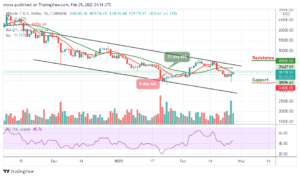
- The digital currency ecosystem has seen extended drawdowns for Bitcoin and altcoins.
- Here is a curated list of 5 potential reasons behind this low investor sentiment.
Top cryptocurrencies, including Bitcoin (BTC), Ethereum (ETH), Solana (SOL), and some memecoins, have succumbed to the current market crash. The crypto market lost $160 billion in just a week as market capitalization plummeted from $2.14 trillion to $1.98 trillion.
Amid the current market downturn, crypto research companies like QCP and 10X Research continue to have a bullish mid- to long-term outlook.
Why BTC, ETH, SOL, XRP, and Meme Coins are Crashing
At press time, Bitcoin, the leading cryptocurrency, was trading at $56,366, demonstrating a 2.8% decline in 24 hours. The current outlook raises concerns among market participants for a coin whose price surpassed the $70,000 range in April.
Ethereum is also following a similarly negative trajectory, with prices decreasing by 1.9% in the past day to $2,410. Also, Solana’s value dropped sharply by 0.5% daily, while Dogecoin’s price decreased by 1.57%.
Some possible factors causing investors’ negative outlook in the crypto market include a historically bearish September, macroeconomic events, and technical chart weakness. The current crypto market crash comes despite optimism about interest rate cuts in September due to falling inflation in the US.
Here are the top five reasons behind the declining prices of BTC, ETH, SOL, XRP, and memecoins.
A Bearish September for Crypto Market and Stocks
September has historically been a tough month for the crypto and traditional market. Thus, the current downturn in the crypto market is reminiscent of how prices of other asset classes have dropped in September in recent years. Gold has dropped sharply every September since 2017, while Bonds were lower in 8 out of the last 10 September.
Meanwhile, the Dow Jones, the S&P 500, and the Nasdaq Composite plummeted by 1.51%, 2.12%, and 3.26%, respectively, their largest decline since the selloff on August 5. Additionally, CoinGlass data shows that $200 million worth of crypto was liquidated in the last 24 hours.
Out of these liquidations, over $173 million is linked to long traders and $27 million in shorts amid the bearish sentiment. The negative sentiment in the crypto market is further reinforced by the crypto Fear & Greed Index, showing fear at 27.
Japan’s Central Bank Governor Confirms Further Rate Hike
Bank of Japan Governor Kazuo Ueda reiterated further rate hikes in a document submitted to a government panel chaired by outgoing Prime Minister Fumio Kishida. The news of the rate hike, Nvidia-led tech selloff, and US recession cues caused the Japanese stock index, Nikkei 225, to plunge 4.24% today.
Economists surveyed revealed that BOJ will likely hike rates again by the end of the year. However, Pacific Investment Management forecasts a rate hike in January. Traders are concerned a crypto market crash is imminent due to hedge funds’ growing Japanese yen carry trades.
Outflows from Spot Bitcoin and Ethereum ETFs
The spot Bitcoin Exchange-Traded Funds (ETFs) launched in the US have seen a fifth consecutive outflow, contributing to reduced investor interest in the crypto market. On Tuesday, spot Bitcoin ETFs had a net outflow of $287.8 million. To complement this, Fidelity’s FBTC surprisingly experienced the largest outflow of $162.3 million, surpassing even GBTC recently.
In a similar move, spot Ethereum ETFs recorded net outflows of $47.4 million on Tuesday. These ETFs started the first trading day of the month with outflows not seen in the previous weeks.
DOJ Investigating Nvidia for Antitrust Investigation
The US Department of Justice (DOJ) recently issued subpoenas to AI chip giant Nvidia, intensifying its antitrust investigation into the company. Investors’ immediate reaction to the regulator’s scrutiny is also linked to the current crypto market downturn.
This development brought back a reminder of the crashed markets in 2000 that resulted from the Microsoft antitrust case. At the time, the Nasdaq stock index fell by 75% from March 2000 to October 2002.
Weak ISM Manufacturing PMI Data
Finally, yesterday’s crypto market crash came after weak ISM Manufacturing PMI data. This data shows a slowdown in factory activity for a fifth consecutive month. Notably, the ISM Manufacturing PMI came in at 47.2 in August, missing market expectations of 47.5.
This data has raised concerns regarding a potential recession. As a result, investors are now looking toward upcoming job data, non-farm payrolls, the unemployment rate, and JOLTs job openings this week.






















